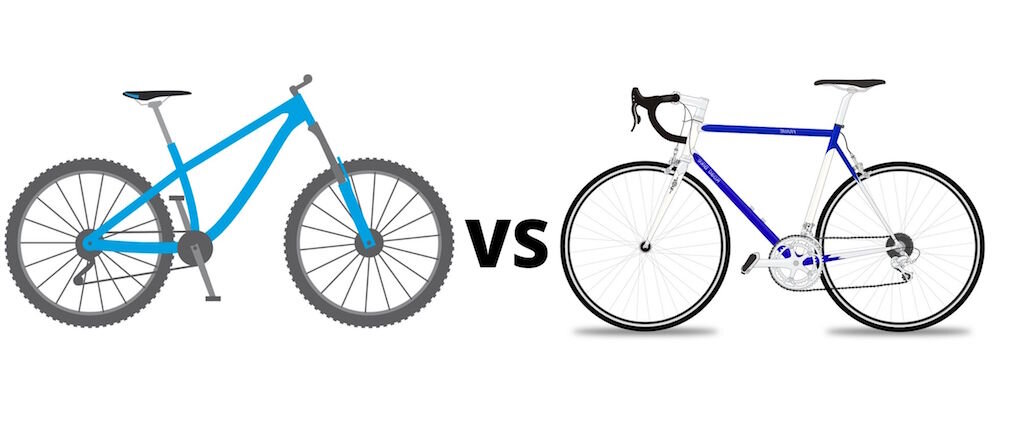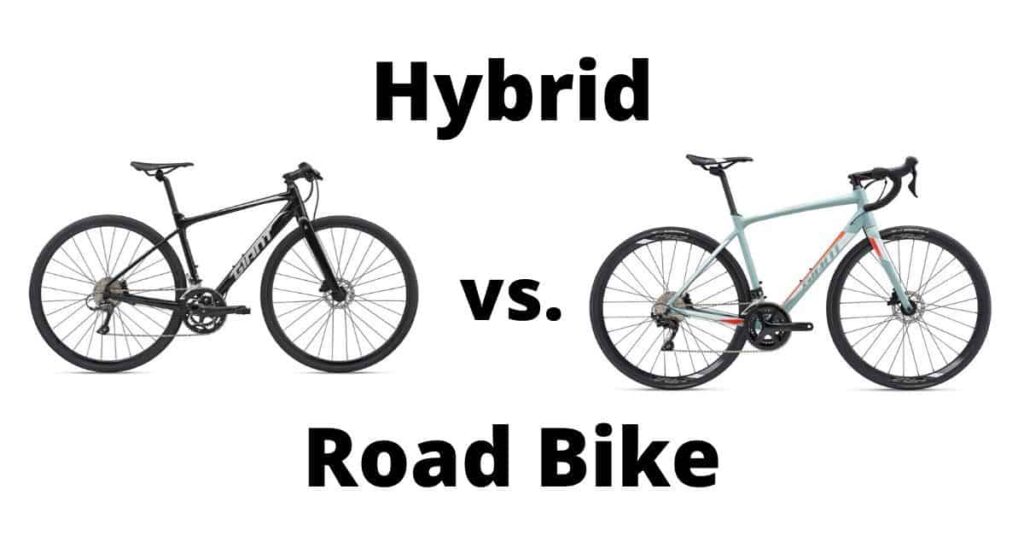Road bikes are designed for speed on smooth surfaces. Mountain bikes excel in rough terrains, offering stability and control.
This raises a common question among cycling enthusiasts: Are road bikes faster than mountain bikes? Understanding the differences between road bikes and mountain bikes is crucial. Road bikes are built for efficiency and speed. They are lightweight with slim tires, perfect for pavement.
Mountain bikes, on the other hand, are robust with thicker tires. They handle obstacles like rocks and mud with ease. Comparing these two types helps you choose the right bike for your needs. Speed is not the only factor.
Consider terrain, comfort, and intended use. This comparison will guide you in making an informed decision, whether you ride for leisure or seek thrilling adventures.

Credit: www.youtube.com
Introduction To Bike Types
Choosing the right bike can be confusing. Each type has unique features. Road bikes and mountain bikes offer different experiences. Understanding their design helps in decision-making.
Road Bikes Overview
Road bikes are designed for speed. They have thin tires and lightweight frames. Riders sit in a forward position. This reduces air resistance. Road bikes perform well on smooth surfaces. Their gears are optimized for flat or uphill terrain.
Mountain Bikes Overview
Mountain bikes are built for rough trails. They have thick, knobby tires. The frames are sturdy and durable. Riders sit upright for better control. Mountain bikes handle uneven surfaces with ease. They feature shock absorbers for comfort. Gears are suited for steep climbs and descents.
Design And Structure
Road bikes offer lightweight frames and aerodynamic designs, making them faster on paved roads. Mountain bikes have sturdier builds for rough terrains, slowing them down on streets. Design influences speed, favoring road bikes for smooth paths.
When considering the question, “Are road bikes faster than mountain bikes?” it’s essential to dive into the design and structure of each type of bike. These two-wheelers may look similar at a glance, but their differences in frame geometry and tire design significantly impact their speed and performance. Let’s explore how these elements contribute to the distinct riding experiences they offer.
Frame Geometry
The frame geometry of a bike influences how it handles and performs. Road bikes typically feature a lightweight, aerodynamic frame that encourages a forward-leaning position. This design reduces air resistance, allowing you to cut through the wind with ease.
In contrast, mountain bikes are built for rugged terrain. Their frames are sturdier and heavier, designed to withstand bumps and jumps. The geometry supports an upright position, offering better control and comfort on uneven surfaces. Have you ever noticed how mountain bikes seem more comfortable on rocky paths? That’s the frame geometry at work.
Tire Differences
Tires play a pivotal role in determining a bike’s speed and grip. Road bikes are equipped with narrow, smooth tires that minimize friction on paved surfaces. This design allows you to ride faster with less effort. Imagine gliding effortlessly on a smooth road—those tires make it possible.
Mountain bikes, however, sport wider tires with deep treads for enhanced grip. These tires are perfect for off-road adventures, providing the traction needed to navigate muddy trails and rocky paths. While they might slow you down on asphalt, they excel in providing stability where it counts.
Understanding these differences can help you choose the right bike for your needs. Are you looking to race on smooth roads or conquer rugged trails? Each bike has its strengths, and knowing them can make all the difference in your riding experience.
Weight And Material
Choosing between road bikes and mountain bikes involves considering many factors. One crucial aspect is their weight and material. These elements significantly influence performance and speed.
Material Composition
Road bikes usually feature lightweight materials like carbon fiber or aluminum. These materials reduce weight without sacrificing strength. Mountain bikes, on the other hand, often use heavier materials. Steel or reinforced aluminum provides durability for rough terrains. The choice of material impacts the bike’s weight and agility.
Impact On Speed
The lighter the bike, the faster it can go. Road bikes benefit from reduced weight, making them swift on paved roads. Their materials focus on speed and efficiency. Mountain bikes prioritize strength and resilience, affecting their speed on flat surfaces. The added weight from sturdy materials slows them down. But it provides stability on rugged paths. Lighter road bikes excel in speed, while mountain bikes offer reliability in challenging conditions.
Aerodynamics
Road bikes often surpass mountain bikes in speed due to their aerodynamic design. Slim tires and light frames reduce resistance, making them faster on paved roads. Mountain bikes, built for rough terrain, prioritize durability over speed, influencing their performance on smooth surfaces.
Aerodynamics is a pivotal factor in determining the speed of a bike. It can make the difference between a leisurely ride and a swift sprint. Road bikes are often hailed for their aerodynamic efficiency compared to mountain bikes. But what exactly gives road bikes the edge in speed? Let’s delve into the specifics of rider position and wind resistance to understand why aerodynamics play such a crucial role.
Rider Position
Your riding position on a road bike is designed for speed. The handlebars are positioned lower, encouraging a more crouched posture. This reduces your body’s frontal area, making you less of a target for wind resistance.
In contrast, mountain bikes have higher handlebars that promote a more upright position. This might be more comfortable, especially on rugged terrains, but it exposes more of your body to the wind, slowing you down on flat roads.
Imagine you’re racing against your friends. On a road bike, your streamlined position gives you a natural advantage. You slice through the air with less effort, leaving your mountain bike buddies trailing behind.
Wind Resistance
Wind resistance is an invisible but potent force that can significantly impact your biking speed. A road bike’s slim tires and lightweight frame are designed to minimize this resistance. The narrow tires have less surface area touching the ground, reducing drag and helping you glide forward more effortlessly.
Mountain bikes, with their wider tires and bulkier frames, aren’t as aerodynamic. These features are excellent for gripping loose dirt or rocky paths but can act like a parachute against the wind on open roads.
Think about those times you’ve battled strong winds on a ride. On a road bike, you can cut through the gusts with relative ease, while on a mountain bike, you might feel like you’re fighting against an invisible wall.
Are you currently choosing between a road bike and a mountain bike? Consider where you’ll be riding most often. If speed is your goal, especially on paved surfaces, the aerodynamic advantages of a road bike might be the deciding factor. But if your adventures take you off-road, a mountain bike’s rugged design may be worth the trade-off in speed.
Terrain And Performance
Road bikes generally perform faster on smooth, paved surfaces due to their lightweight frames and thin tires. Mountain bikes excel on rugged terrains, providing stability and control with their durable build and wider tires. Both bikes have unique strengths tailored to different riding conditions.
When deciding between road bikes and mountain bikes, one crucial factor to consider is how each performs on different terrains. Both types of bikes are designed with specific surfaces in mind, which significantly impacts their speed and efficiency. Understanding the terrain and performance aspects can help you choose the right bike for your needs.
Smooth Surfaces
On smooth surfaces like asphalt or paved roads, road bikes excel. They are designed with thin, high-pressure tires that minimize friction, allowing you to glide effortlessly. Their lightweight frames and aerodynamic design also contribute to higher speeds.
Picture this: you’re riding on a long, straight road with a gentle breeze at your back. A road bike will enable you to maintain a swift pace with little effort. If your primary riding involves commuting or long-distance rides on paved paths, a road bike might be your best bet.
However, think about this: what happens when the road is not perfectly smooth? A slight bump or crack can be jarring, sometimes even causing you to lose control. This is where mountain bikes have an edge.
Rough Terrain
Mountain bikes are built for rough terrain. Their wider, knobbier tires provide better grip and stability on dirt paths, gravel, and rocky trails. The suspension systems absorb shocks from uneven surfaces, giving you a smoother ride.
Imagine tackling a rugged trail with unexpected obstacles like roots and rocks. A mountain bike will handle these challenges with ease, giving you more control and confidence. It’s designed to endure the unpredictable and often harsh conditions of off-road cycling.
But there’s a trade-off. The same features that make mountain bikes excellent for rough terrain can slow you down on smooth surfaces. The tires create more friction, and the heavier frame can make long rides more tiring.
Have you ever considered how often you ride on mixed terrains? If your routes include a blend of smooth and rough surfaces, it might be worth assessing how often you encounter each type. This can guide you in selecting a bike that aligns with your typical riding conditions.
In the end, your decision might come down to where you plan to ride most often. If your adventures frequently lead you off the beaten path, a mountain bike could be your ideal companion. But if speed on smooth roads is your priority, a road bike might be more suitable.

Credit: www.youtube.com
Gear Ratios And Speed
Understanding gear ratios can be crucial in determining whether road bikes are faster than mountain bikes. Gear ratios influence how efficiently you can transfer power to your wheels, impacting your speed. Let’s explore how different gearing affects the performance of road bikes and mountain bikes.
Road Bike Gearing
Road bikes are designed for speed and efficiency on paved surfaces. They typically have higher gear ratios, which means fewer pedal rotations for more wheel rotations. This setup allows you to maintain high speeds with less effort.
Imagine cruising on a road bike during a weekend ride. You can feel the breeze as you effortlessly glide over smooth roads. The higher gears let you accelerate quickly, perfect for overtaking or sprinting to the finish line.
However, this high gearing might make steep climbs more challenging. You may find yourself standing on the pedals, pushing harder to conquer that hill. It’s a trade-off between flat speed and climbing efficiency.
Mountain Bike Gearing
Mountain bikes are designed to tackle rough terrains and steep hills. They often have lower gear ratios, making it easier to pedal at lower speeds. This feature is essential for climbing steep trails and navigating obstacles.
Imagine tackling a rocky trail on a mountain bike. The lower gears allow you to maintain control and power through challenging sections. You can climb steep hills without exhausting yourself, thanks to the easier pedaling.
While this gearing excels off-road, it might limit your speed on flat roads. You may find yourself spinning your legs rapidly but not gaining much speed. This can make long road rides more tiring compared to a road bike.
So, are road bikes faster than mountain bikes? It depends on the terrain and your riding goals. Have you ever tried both on different terrains? Which did you find more enjoyable and efficient for your needs?
Practical Speed Tests
When comparing road bikes and mountain bikes, speed is a key factor. Practical speed tests offer valuable insights into their performance in different terrains. Both bike types excel in specific conditions, but which one truly dominates in speed? Let’s delve into this intriguing comparison.
On-road Comparisons
Road bikes are designed for smooth surfaces. Their narrow tires reduce friction, allowing faster movement. Riders often experience increased speed with less effort. During on-road tests, road bikes consistently outperform mountain bikes. Their aerodynamic design enhances speed. Lower weight also contributes to their swift nature. Mountain bikes, with wider tires, face more rolling resistance. This resistance slows them on flat roads. Despite this, mountain bikes provide stability and comfort.
Off-road Comparisons
Mountain bikes thrive on rugged terrains. Their sturdy frames withstand uneven surfaces. Wide tires offer better grip, crucial for off-road trails. Speed tests on such terrains show mountain bikes take the lead. Road bikes struggle with bumps and obstacles. Their design prioritizes speed over durability. In off-road conditions, mountain bikes offer greater control. Their suspension systems absorb shocks, enhancing rider comfort. Road bikes lack this capability, affecting their performance.

Credit: www.gzsamebike.com
Choosing The Right Bike
Road bikes often offer faster speeds on smooth surfaces due to their lightweight design and slim tires. Mountain bikes excel on rough terrains with sturdy frames and wide tires, making them slower on flat roads. Choosing depends on your preferred riding environment and speed requirements.
Choosing the right bike involves understanding your needs. Road bikes and mountain bikes each have unique features. Selecting the best one depends on your goals and lifestyle.
Purpose And Usage
First, think about where you’ll ride most often. Road bikes are made for paved surfaces. They excel in speed and efficiency on smooth roads. Mountain bikes handle rough terrains well. They’re perfect for trails, hills, and off-road adventures. Consider your usual routes. This helps determine the ideal bike type.
Personal Preferences
Personal comfort and style matter too. Some prefer the lightweight feel of a road bike. Others enjoy the sturdy build of a mountain bike. Think about how each bike feels. Test rides can help you decide. Also, consider aesthetics. Do you prefer sleek road bike designs? Or the robust look of mountain bikes? Personal taste plays a big role in choosing the right bike.
Frequently Asked Questions
Which Is Faster Road Bike Or Mountain Bike?
Road bikes are generally faster than mountain bikes on paved roads. Their lightweight frames and thin tires reduce resistance. Mountain bikes are designed for off-road terrains, making them slower on smooth surfaces. For road cycling, a road bike is the better choice for speed.
Is It Easier To Go Faster On A Road Bike?
Yes, road bikes are designed for speed. Their lightweight frames and aerodynamic features make them faster on paved surfaces. Thin tires and efficient gearing contribute to enhanced speed, making them ideal for cycling enthusiasts seeking a quick ride. Overall, road bikes are optimal for achieving higher speeds with less effort.
Is It Harder To Ride A Mountain Bike Or A Road Bike?
Mountain biking is often harder due to rough terrains and technical trails. Road biking requires less technical skill but demands endurance for long distances. The difficulty depends on personal experience and the type of terrain. Each offers unique challenges and benefits for cycling enthusiasts.
Conclusion
Choosing between road and mountain bikes depends on your goals. Road bikes excel in speed, perfect for city streets and smooth paths. They offer efficiency with lighter frames and thin tires. Mountain bikes shine in rugged terrains, handling bumps and dirt with ease.
Their sturdy build and wide tires provide stability off-road. Consider your riding preferences and the paths you enjoy. Speed lovers might prefer road bikes, while adventure seekers lean towards mountain bikes. Both types have unique strengths. Your choice defines your cycling experience.
Enjoy the ride, no matter which bike you choose!



